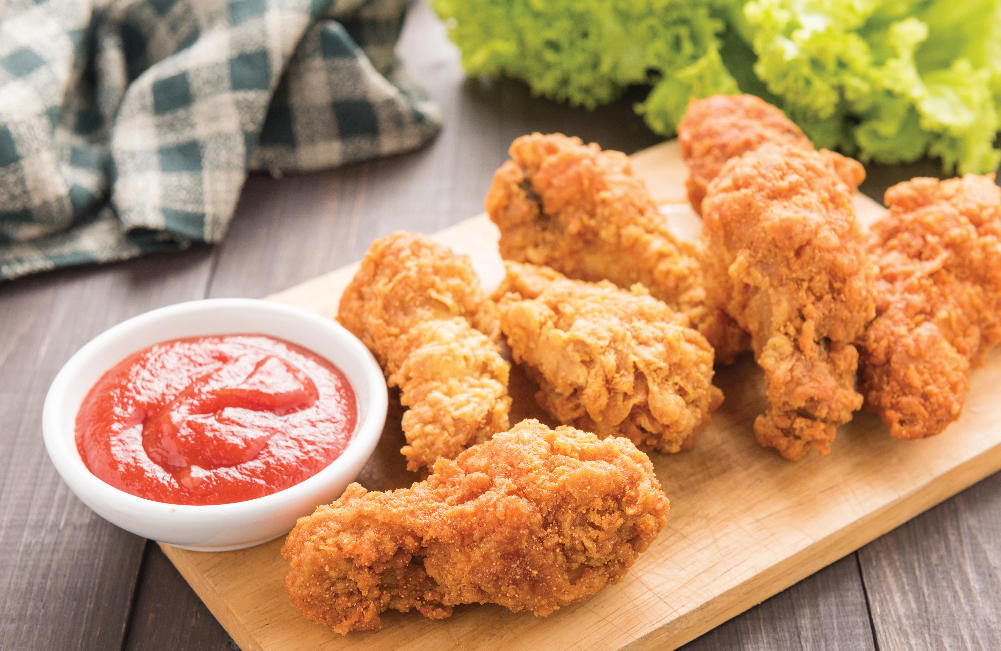-
The Secret Science Behind Perfectly Crispy Fried Chicken

There’s nothing quite as satisfying as biting into a piece of fried chicken that’s golden, crunchy on the outside, and tender on the inside. While fried chicken may seem like a simple comfort food, creating the perfect crisp is an art backed by science. From oil temperature to the type of flour, each step plays a role in achieving the ultimate crunch. In this guide, we’ll break down the science of crispy fried chicken and how you can master it at home.
Why Fried Chicken Crisps Differently
When frying, two processes occur at the same time: the Maillard reaction and moisture evaporation. The Maillard reaction is a chemical process between proteins and sugars that creates golden colour and rich flavour. Moisture evaporation, meanwhile, prevents the batter from becoming soggy by forcing steam outwards, keeping the inside juicy while crisping the coating. Mastering these processes ensures your fried chicken comes out perfectly every time.
The Role of Marinades: Tender and Juicy Chicken
Before the frying even begins, marination plays a vital role in texture and flavour. Buttermilk marinades are especially effective because the acidity tenderises the chicken while enzymes break down proteins. Adding spices such as paprika, garlic powder, and black pepper infuses the meat with depth. Ideally, marinate your chicken for at least 4 hours, or overnight for best results. This step locks in juiciness so the chicken doesn’t dry out during frying.
Choosing the Right Flour and Coating
Your coating determines the crunch factor. A mix of all-purpose flour and cornstarch is a winning combination: flour provides structure, while cornstarch reduces gluten development, resulting in a lighter, crispier crust. Some chefs also add rice flour for an extra shatter-like texture. Seasoning the flour with salt, pepper, and herbs ensures flavour penetrates every bite. For a double crunch, dip the chicken in flour, then buttermilk, and coat it in flour again before frying.
Oil Temperature: The Critical Factor
Getting oil temperature right is the most crucial part of making crispy fried chicken. The sweet spot is 160–175°C (320–350°F). At this range, the coating crisps quickly without burning, while the chicken cooks evenly inside.
- Too low (<160°C): The chicken absorbs oil, becoming greasy and heavy.
- Too high (>180°C): The crust burns before the meat cooks through.
A kitchen thermometer is the best way to monitor oil temperature. If you don’t have one, test by dropping in a small piece of batter – if it bubbles steadily and rises to the surface, the oil is ready.
The Double-Fry Technique
Many professionals swear by the double-fry method, and for good reason. The first fry cooks the chicken through, while the second fry at a slightly higher temperature crisps up the outer coating. This method also ensures the crust stays crunchy even after the chicken cools down. Korean fried chicken is famous for using this technique to achieve extra-thin, glassy-crisp skins.
Resting and Draining Correctly
Once your chicken is fried, resist the urge to stack it straight away. Placing fried chicken on paper towels traps steam, which softens the crust. Instead, rest it on a wire rack to let excess oil drain while keeping the exterior crispy. A few minutes of resting also allows juices to redistribute, ensuring moist bites from start to finish.
Seasoning After Frying
While seasoning the flour mixture is important, a final sprinkle of salt or spice blend right after frying enhances flavour. Paprika, cayenne, or even flavoured salts can elevate your fried chicken from ordinary to gourmet. Adding seasoning while the chicken is still hot helps the flavours stick better.
Common Mistakes to Avoid
Even experienced cooks slip up when making fried chicken. Here are some pitfalls to avoid:
- Skipping the marinade: This leads to dry, bland chicken.
- Overcrowding the pan: This lowers oil temperature, resulting in soggy chicken.
- Wrong oil choice: Always use oils with a high smoke point, like peanut, canola, or sunflower oil.
- Not letting it rest: Skipping this step makes the crust lose its crunch.
Variations of Crispy Fried Chicken
The beauty of fried chicken is its versatility across cultures:
- Southern-style fried chicken: Classic buttermilk and spiced flour.
- Korean fried chicken: Double-fried with sweet, sticky sauces.
- Japanese karaage: Soy-marinated, bite-sized chicken with potato starch coating.
- Nashville hot chicken: Spicy fried chicken brushed with cayenne oil.
Exploring these variations gives you a taste of global culinary traditions, all rooted in the same science of crispness.
Final Thoughts: Science Meets Comfort Food
Perfectly crispy fried chicken is more than a guilty pleasure – it’s a science experiment with delicious results. By understanding marination, flour chemistry, oil temperature, and frying techniques, you can replicate restaurant-level fried chicken in your own kitchen. So the next time you crave comfort food, grab a thermometer, prepare your marinade, and put the science of crispiness to the test.